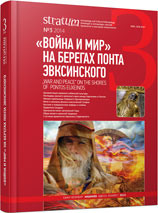Лепные курильницы из памятников Северного Причерноморья IV—I вв. до н. э.
Hand-Molded Incense Cups from the Northern Black Sea Coast Sites of 4th—1st Centuries BC
Author(s): Vitalii S. Sinika, Vera A. Menshikova, Nicolai P. TelnovSubject(s): History, Archaeology, Ancient World
Published by: Издательский дом Stratum, Университет «Высшая антропологическая школа»
Keywords: Northern Black Sea Coast; Dniester Region; Bug Region; Crimea; Dnieper Region; Don Region; 4th—1st centuries BC; hand-molded incense cups; ornament
Summary/Abstract: The article deals with hand-made incense cups of the North Black Sea Coast of 4th—1st centuries BC. Given the large number of censers found during the excavation of the Scythian barrow cemetery near village Glinoe in the Dniester region, the authors revised all known similar finds and proposed a typology of these vessels. They substantiated the origin of the fluted incense cups from similar vessels common among Meotian tribes of the Kuban Region. Their way of penetration into the North Black Sea Coast is outlined. Censers with ornaments with solar symbols, apparently, represent the Crimean tradition in the manufacture of such vessels. Such ornamental patterns like “fishbone” and groups of lines falling down from a line on the shoulder of a vessel seem to be of Scythian origin. The origin of censers without any ornament is more complicated some of them — with a distinguished foot — can testify to the Greek influence, some other — with a flat bottom — indicate the use of Scythian form of hand-made pots.
Journal: Stratum plus. Археология и культурная антропология
- Issue Year: 2014
- Issue No: 3
- Page Range: 65-101
- Page Count: 37
- Language: Russian

